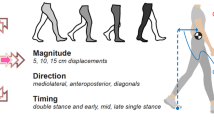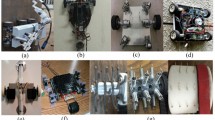Abstract
In this study, we present a novel neural control architecture for gait adaptation and obstacle avoidance of a tailless gecko robot. The control architecture is based on a hierarchical modular structure, consisting of several neural layers and modules. The first layer contains three sensory preprocessing modules which filter sensory noise and generate appropriate descending commands to activate corresponding behaviors through the second and third layers. The second and third layers contain a central pattern generator (CPG) module and CPG postprocessing modules, respectively. The CPG module generates basic rhythmic locomotion patterns, shaped by the CPG postprocessing modules to achieve different gaits (i.e., wave, intermediate, and trot) as well as different climbing directions (i.e., forward and sideways). We use a body inclination sensor to adapt the robot gait while climbing on different slope angles, with infrared sensors to detect an obstacle on its climbing path and activate obstacle avoidance behavior. We successfully tested our control approach on a real tailless gecko robot. As a result, the robot can efficiently climb forward on different slope angles (including 90∘) and automatically adapt its climbing gait accordingly, to maximize climbing speed and ensure stability. It can also avoid an obstacle by changing its climbing direction from forward to sideways.
Similar content being viewed by others
References
Seibel, A., Schiller, L.: Systematic engineering design helps creating new soft machines. Robotics and Biomimetics 5(1), 5 (2018)
Schiller, L., Seibel, A., Schlattmann, J.: Toward a gecko-inspired, climbing soft robot. Front. Neurorobot. 13, 106 (2019)
Srisuchinnawong, A., Shao, D., Ngamkajornwiwat, P., Teerakittikul, P., Dai, Z., Ji, A., Manoonpong, P.: Neural control for gait generation and adaptation of a gecko robot. In: 2019 19th International Conference on Advanced Robotics (ICAR), pp. 468–473. IEEE (2019)
Gorb, S., Varenberg, M., Peressadko, A., Tuma, J.: Biomimetic mushroom-shaped fibrillar adhesive microstructure. J. R. Soc. Interface 4(13), 271–275 (2007)
Autumn, K., Gravish, N.: Gecko adhesion: evolutionary nanotechnology. Philos. Trans. Royal Soc. A: Math. Phys. Eng. Sci. 366(1870), 1575–1590 (2008)
Wang, Z., Wang, Z., Dai, Z., Gorb, S.N.: Bio-inspired adhesive footpad for legged robot climbing under reduced gravity: multiple toes facilitate stable attachment. Appl. Sci. 8(1), 114 (2018)
Raut, H.K., Baji, A., Hariri, H.H., Parveen, H., Soh, G.S., Low, H.Y., Wood, K.L.: Gecko-inspired dry adhesive based on micro–nanoscale hierarchical arrays for application in climbing devices. ACS Appl. Mater. Interfaces 10(1), 1288–1296 (2018)
Autumn, K., Hsieh, S., Dudek, D., Chen, J., Chitaphan, C., Full, R.: Dynamics of geckos running vertically. J. Exp. Biol. 209(2), 260–272 (2006)
Chen, R.: A gecko-inspired electroadhesive wall-climbing robot. IEEE Potentials 34(2), 15–19 (2015)
Daltorio, K.A., Gorb, S., Peressadko, A., Horchler, A.D., Ritzmann, R.E., Quinn, R.D.: A robot that climbs walls using micro-structured polymer feet. In: Climbing and Walking Robots, pp. 131–138. Springer (2006)
Chen, R., Fu, L., Qiu, Y., Song, R., Jin, Y.: A gecko-inspired wall-climbing robot based on vibration suction mechanism. Proc. Inst. Mech. Eng. C. J. Mech. Eng. Sci. 233(19-20), 7132–7143 (2019)
Yu, Z., Wang, Z., Liu, R., Wang, P., Dai, Z.: Stable gait planning for a gecko-inspired robot to climb on vertical surface. In: 2013 IEEE International Conference on Mechatronics and Automation, pp. 307–311. IEEE (2013)
Medger, K., Verburgt, L., Bateman, P.W.: The influence of tail autotomy on the escape response of the cape dwarf gecko, lygodactylus capensis. Ethology 114(1), 42–52 (2008)
Unver, O., Uneri, A., Aydemir, A., Sitti, M.: Geckobot: A gecko inspired climbing robot using elastomer adhesives. In: Proceedings 2006 IEEE International Conference on Robotics and Automation, 2006. ICRA 2006, pp. 2329–2335. IEEE (2006)
Rossignol, S., Dubuc, R., Gossard, J.P.: Dynamic sensorimotor interactions in locomotion. Physiol. Rev. 86(1), 89–154 (2006)
Manoonpong, P., Pasemann, F., Roth, H.: Modular reactive neurocontrol for biologically inspired walking machines. Int. J. Rob. Res. 26(3), 301–331 (2007)
Ijspeert, A.J.: Central pattern generators for locomotion control in animals and robots: a review. Neural Netw. 21(4), 642–653 (2008)
Manoonpong, P., Parlitz, U., Wörgötter, F.: Neural control and adaptive neural forward models for insect-like, energy-efficient, and adaptable locomotion of walking machines. Front. Neural Circuits 7, 12 (2013)
Leung, B., Thor, M., Manoonpong, P.: Modular neural control for bio-inspired walking and ball rolling of a dung beetle-like robot. In: Artificial Life Conference Proceedings, pp. 335–342. MIT Press (2018)
Sun, T., Shao, D., Dai, Z., Manoonpong, P.: Adaptive neural control for self-organized locomotion and obstacle negotiation of quadruped robots. In: 2018 27th IEEE International Symposium on Robot and Human Interactive Communication (RO-MAN), pp. 1081–1086. IEEE (2018)
Broomhead, D., Lowe, D.: Radial basis functions, multi-variable functional interpolation and adaptive networks. Royal signals and radar establishment; 1988. report no. Ann. Stat. 26(3), 801–849 (1998)
Park, J., Sandberg, I.W.: Universal approximation using radial-basis-function networks. Neural Comput. 3(2), 246–257 (1991)
Pitchai, M., Xiong, X., Thor, M., Billeschou, P., Mailänder, P.L., Leung, B., Kulvicius, T., Manoonpong, P.: Cpg driven rbf network control with reinforcement learning for gait optimization of a dung beetle-like robot. In: International Conference on Artificial Neural Networks, pp. 698–710. Springer (2019)
Stone, G.O.: An analysis of the delta rule and the learning of statistical associations. Parallel Distributed Processing: Explorations in the Microstructure of Cognition 1, 444–459 (1986)
Ganguli, S., Huh, D., Sompolinsky, H.: Memory traces in dynamical systems. Proc. Natl. Acad. Sci. 105(48), 18970–18975 (2008)
Goldschmidt, D., Wörgötter, F., Manoonpong, P.: Biologically-inspired adaptive obstacle negotiation behavior of hexapod robots. Front. Neurorobot. 8, 3 (2014)
Manoonpong, P., Pasemann, F., Wörgötter, F.: Sensor-driven neural control for omnidirectional locomotion and versatile reactive behaviors of walking machines. Robot. Auton. Syst. 56(3), 265–288 (2008)
Lin, H.W., Tegmark, M., Rolnick, D.: Why does deep and cheap learning work so well? J. Stat. Phys. 168(6), 1223–1247 (2017)
Ji, A., Zhao, Z., Manoonpong, P., Wang, W., Chen, G., Dai, Z.: A bio-inspired climbing robot with flexible pads and claws. J. Bionic Eng. 15(2), 368–378 (2018)
Sun, T., Xiong, X., Dai, Z., Manoonpong, P.: Small-sized reconfigurable quadruped robot with multiple sensory feedback for studying adaptive and versatile behaviors. Front. Neurorobot. 14, 14 (2020)
Xiong, X., Manoonpong, P.: Adaptive motor control for human-like spatial-temporal adaptation. In: 2018 IEEE International Conference on Robotics and Biomimetics (ROBIO), pp. 2107–2112. IEEE (2018)
Thor, M., Kulvicius, T., Manoonpong, P.: Generic neural locomotion control framework for legged robots. IEEE Transactions on Neural Networks and Learning Systems. https://doi.org/10.1109/TNNLS.2020.3016523 (2020)
Acknowledgments
This work was supported by the NSFC-DFG Collaborative Research Program of the National Natural Science of Foundation of China under Grant 51861135306, the NUAA Research Fund, and in part from the startup grant on Bio-inspired Robotics provided by Vidyasirimedhi Institute of Science and Technology (VISTEC).
Author information
Authors and Affiliations
Corresponding author
Additional information
Publisher’s Note
Springer Nature remains neutral with regard to jurisdictional claims in published maps and institutional affiliations.
A. Srisuchinnawong and B. Wang contributed equally to this work
Electronic supplementary material
Below is the link to the electronic supplementary material.
(MP4 92.1 MB)
(MP4 123 MB)
Rights and permissions
About this article
Cite this article
Srisuchinnawong, A., Wang, B., Shao, D. et al. Modular Neural Control for Gait Adaptation and Obstacle Avoidance of a Tailless Gecko Robot. J Intell Robot Syst 101, 27 (2021). https://doi.org/10.1007/s10846-020-01285-y
Received:
Accepted:
Published:
DOI: https://doi.org/10.1007/s10846-020-01285-y




